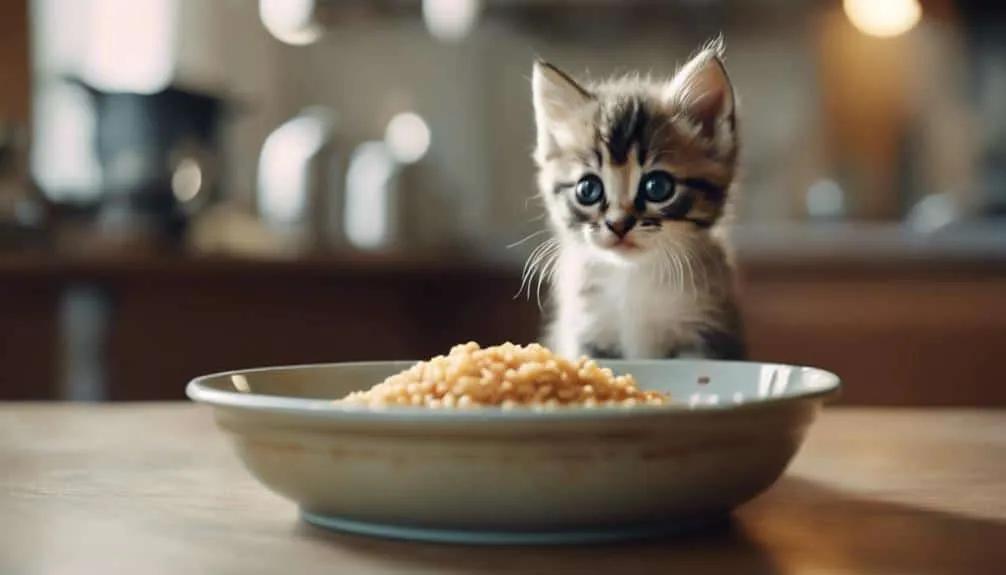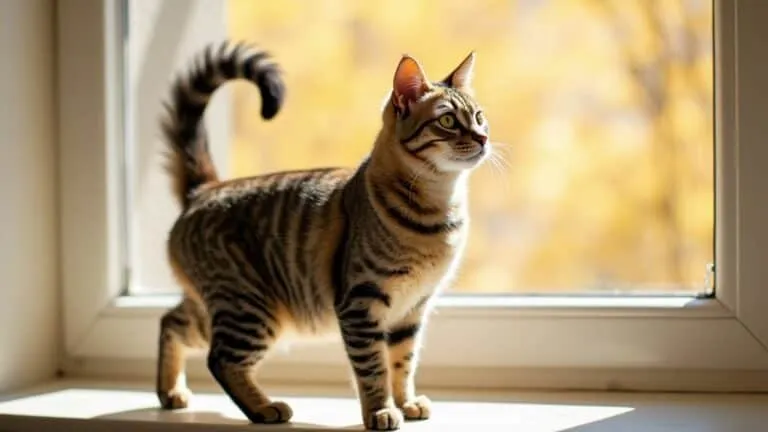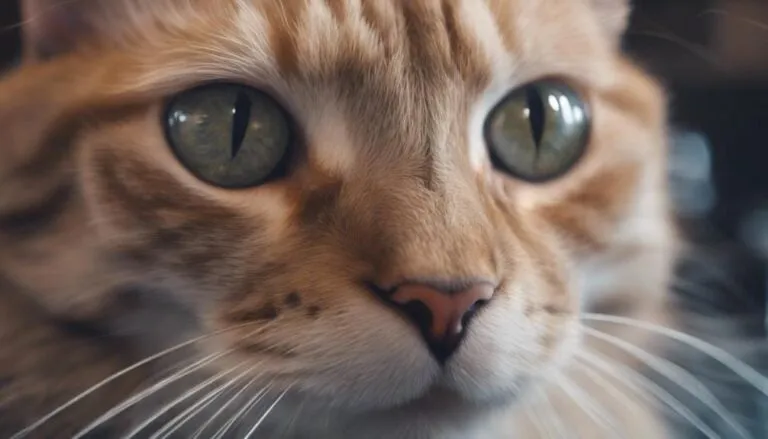The Best Fluffy Pancakes recipe you will fall in love with. Full of tips and tricks to help you make the best pancakes.

If you've ever wondered about the surprising fact that some cat breeds can weigh as little as 5 pounds, you may be curious to explore why your feline companion falls on the petite side. Understanding the reasons behind your cat's small size can provide valuable insights into their overall well-being and care needs. Explore the factors influencing your cat's size on Catsgeek.com/Why-Is-My-Cat-So-Small and uncover the secrets to promoting their health and happiness.
Key Takeaways
- Genetics play a significant role in determining cat size.
- Nutrition during early stages is crucial for healthy growth.
- Health conditions like hormonal imbalances can affect size.
- Some breeds are naturally small due to genetic traits.
- Environmental factors, like balanced diet and exercise, impact cat size.
Genetics Influence on Cat Size
Examining the genetic makeup of cats can provide valuable insights into why your feline companion may be smaller in size compared to other cats. Size variations in cats are primarily influenced by genetics. Certain genes control the growth patterns of cats, impacting their final size. Factors such as the breed, parents' sizes, and genetic history play a key role in determining the size of a cat.
Different breeds have specific genetic traits that dictate their size characteristics. For instance, breeds like the Singapura tend to be smaller, while Maine Coons are known for their larger size. These size differences are a direct result of the genetic variations within each breed. Growth patterns, controlled by genetic factors, also contribute significantly to the final size of a cat.
Understanding the genetic influence on your cat's size can help you appreciate their uniqueness. By recognizing the role genetics play in determining your cat's size, you can better cater to their individual needs and ensure they lead a healthy and fulfilling life.
Impact of Early Nutrition
Considering the genetic factors that contribute to your cat's size, it's important to also recognize the significant impact of early nutrition on their growth and development. Early development plays a pivotal role in determining your cat's eventual size.
Here's how you can guarantee your cat receives the best nutrition for ideal growth:
- Balanced Diet: Providing a balanced diet rich in essential nutrients is essential for your cat's early development. This includes proteins, fats, vitamins, and minerals necessary for healthy growth.
- Proper Feeding Schedule: Establishing a consistent feeding schedule ensures that your cat receives the necessary nutrition at the right times during their early development stages.
- Consulting a Veterinarian: Seeking guidance from a veterinarian can help you tailor your cat's diet to meet their specific nutritional needs. Veterinarians can provide valuable insights on the best food choices for your cat's growth and development.
Meeting your cat's nutritional needs during their early development stages sets a strong foundation for their overall health and size as they mature.
Health Conditions Affecting Growth
To understand how health conditions can impact the growth of your cat, it's important to recognize the role that various medical issues can play in determining their size and development. Hormonal imbalances, such as growth hormone deficiency, can hinder your cat's growth potential. This deficiency may result in stunted growth and smaller overall size compared to healthy cats.
Malnutrition is another significant factor that can affect your cat's growth. If your cat doesn't receive adequate nutrition, especially during their developmental stages, it can lead to growth retardation and smaller size. Ensuring a balanced and nutritious diet is essential for the proper growth of your cat.
Parasitic infections are also known to impact a cat's growth. Worms and other parasites can deprive your cat of essential nutrients, leading to poor growth and potential health issues. Regular deworming and veterinary check-ups can help prevent parasitic infections and promote healthy growth in your cat.
Breeds Known for Small Cats
Some cat breeds are naturally small due to specific genetic traits that have been selectively bred over time. These tiny cats often exhibit unique characteristics such as petite body size, delicate features, and overall diminutive stature compared to standard cat breeds.
Understanding the distinct traits of miniature feline breeds can help you appreciate the diversity and charm that small cats bring to the world of feline companionship.
Small Cat Breeds
Understanding the variations in sizes that exist within these breeds is crucial when considering tiny cat breeds. Here are some insights on small cat care and growth development:
- Teacup Breeds: These are the tiniest of the tiny cat breeds, often weighing less than 5 pounds.
- Dwarf Cats: Known for their small stature and unique appearances, dwarf cats require specialized care due to their size.
- Miniature Versions: Some cat breeds have mini versions that maintain their breed characteristics but in a smaller size, perfect for those looking for a small yet familiar feline companion.
Traits of Tiny Cats
Tiny cat breeds exhibit distinct physical and behavioral characteristics that set them apart from larger felines. When considering size variations, these breeds tend to have petite frames, weighing less than 10 pounds on average. Despite their small size, they're agile and energetic, requiring regular playtime to stay active and healthy.
Regarding development, tiny cats reach maturity faster than larger breeds, often becoming fully grown by around 1 year of age. Small cat behavior is often described as playful, affectionate, and sometimes even more vocal than their larger counterparts.
When caring for tiny cats, providing them with proper nutrition, regular veterinary check-ups, and plenty of mental stimulation is crucial to keep them happy and engaged.
Miniature Feline Characteristics
Often overlooked, miniature feline breeds boast distinct physical and behavioral traits that differentiate them from their larger counterparts. When caring for these small cats, consider the following:
- Size Management: Miniature felines require specialized care to maintain their petite size. Monitor their diet and exercise to prevent obesity.
- Adorable Personalities: Despite their small stature, these cats often exhibit big personalities. They may be more energetic and playful than larger breeds.
- Affectionate Nature: Small cats are known for their affectionate behavior. They may seek out cuddles and attention more frequently than larger breeds, forming strong bonds with their owners.
Understanding these characteristics will help you provide the best care for your miniature feline companion.
Environmental Factors and Size
When considering why your cat may be small, it's important to explore how genetic influences can impact their size.
Additionally, the nutritional aspects of your cat's diet play a significant role in their growth and development.
Moreover, certain health conditions can affect your cat's size, highlighting the necessity of regular veterinary check-ups.
Genetic Influences on Size
Genetic factors play a significant role in determining the size of cats, with environmental influences also contributing to the final outcome. When it comes to cat size, several important aspects need to be considered:
- Hormonal influences: Hormones play a pivotal role in regulating growth patterns in cats, affecting their overall size.
- Developmental stages: Cats go through various developmental stages that impact their final size, influenced by genetic and environmental factors.
- Size variations: Due to genetic diversity, cats exhibit a wide range of sizes even within the same breed, highlighting the complexity of genetic influences on feline size.
Understanding these factors can help you comprehend why your cat may be smaller or larger than expected, shedding light on the intricate interplay between genetics and environment.
Nutritional Impact on Growth
For cats, the size and growth patterns are greatly influenced by their nutritional intake, emphasizing the significant role of environmental factors in determining their ultimate size. Protein intake plays a vital role in promoting healthy growth for your feline friend. A diet rich in high-quality proteins supports muscle development and overall body growth.
On the other hand, vitamin deficiencies can hinder proper development in cats. Lack of essential vitamins can lead to stunted growth and potential health issues. Ensuring your cat receives a balanced diet with adequate protein and essential vitamins is key to promoting healthy growth and development.
Health Conditions Affecting Size
Health conditions can greatly impact the size of your cat, with environmental factors playing an important role in determining their ultimate growth potential. When it comes to size discrepancies in cats, several factors come into play:
- Weight Management: Proper weight management is essential for ensuring your cat reaches its full growth potential.
- Growth Hormones: Hormonal imbalances can affect the production of growth hormones, leading to stunted growth in cats.
- Dwarfism: Cats can be affected by various forms of dwarfism, which can result in them being smaller in size compared to other cats.
Understanding these health conditions and their impact on your cat's size can help you provide the necessary care and support to ensure they lead a healthy and fulfilling life.
Tips for Promoting Healthy Growth
To support your cat's healthy growth, maintain a balanced diet rich in essential nutrients and provide regular exercise opportunities. A vital diet is essential for your cat's overall health and growth. Guarantee their food contains high-quality proteins, essential fatty acids, vitamins, and minerals. Consult your veterinarian to determine the right diet for your cat's specific needs. Incorporate a variety of wet and dry foods to meet their nutritional requirements. Additionally, make sure your cat has access to fresh water at all times.
Exercise routines are equally important for promoting healthy growth in your cat. Engage your cat in interactive play sessions using toys like feathers, laser pointers, or interactive puzzles to keep them physically active. Consider setting up a cat tree or scratching post to encourage climbing and jumping, which helps build muscle strength. Regular playtime not only supports physical health but also provides mental stimulation, contributing to your cat's overall well-being. By focusing on an essential diet and engaging exercise routines, you can help promote healthy growth and development in your small cat.
Frequently Asked Questions
Can a Small Cat Eventually Grow to Be a Larger Size?
Yes, a small cat can grow to be larger based on genetics and proper nutrition. Growth spurts are common as they mature. Providing the right balance of nutrients and growth hormones can support healthy development.
Are There Any Supplements That Can Help a Cat Grow Bigger?
Dietary supplements and growth hormones can't change a cat's genetic potential for size. Providing balanced nutrition tailored to your cat's needs is essential. Consult a veterinarian to address weight gain and guarantee proper nutritional support.
How Can I Tell if My Cat's Small Size Is Due to Genetics?
To determine if your cat's small size is genetic, consider breed standards. Consult a vet for health concerns. Guarantee proper nutrition tailored to your cat's needs. Monitor growth spurts. Remember, genetics play a significant role in feline size.
Are There Specific Exercises That Can Increase a Cat's Size?
To increase your cat's size, focus on providing appropriate dietary requirements and avoid using growth hormones. Proper nutrition and a healthy lifestyle are key to supporting your cat's growth and overall well-being.
Is There a Correlation Between a Cat's Size and Its Lifespan?
When it comes to a cat's size and lifespan, nutrition impact plays an essential role. Certain breeds may have genetic differences affecting longevity. Remember, a well-balanced diet can contribute to a longer and healthier life for your feline friend.
Conclusion
As you observe your petite feline companion, remember that their small size isn't just a physical trait, but a symbol of their unique genetic makeup and individuality.
By providing proper care, nutrition, and attention, you can nurture their growth and health.
Embrace the charm of your small cat, knowing that their size is just one aspect of the special bond you share.
Your tiny companion is a precious gem in the vast world of feline diversity.










